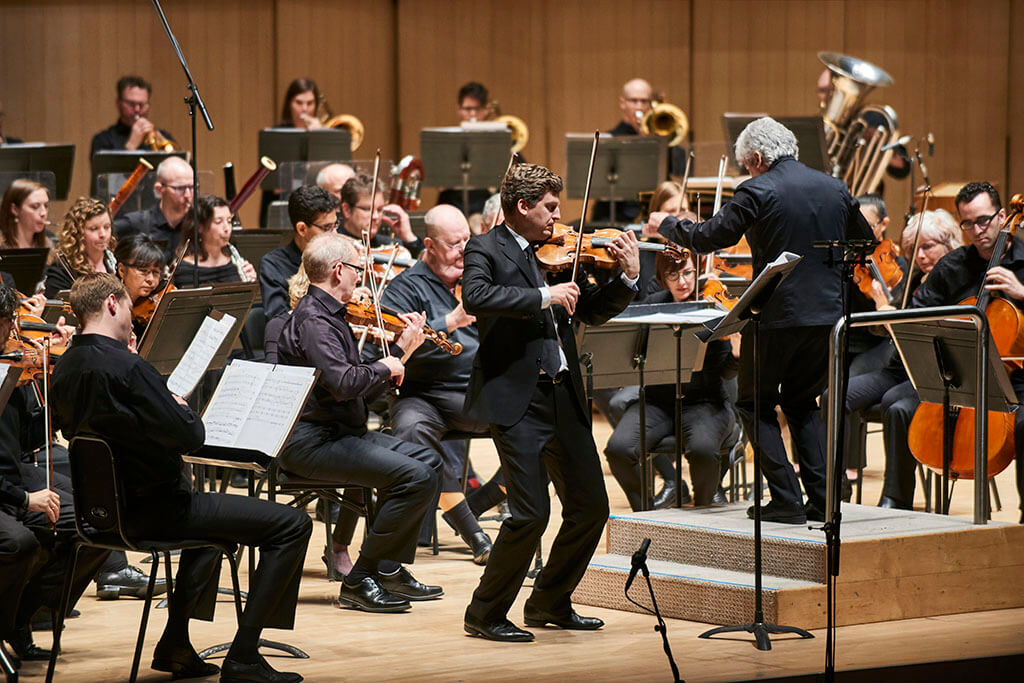
Toronto Symphony Orchestra New Creations Festival. With violinist James Ehnes and bass-baritone Daniel Okulitch. Peter Oundjian and André de Ridder, conductors. Roy Thomson Hall. March 8.
The second of three Toronto Symphony Orchestra New Creations Festival concerts at Roy Thomson Hall on Wednesday night was a feast of virtuosity, a panorama of orchestral colour, and a meeting up of diverse musical styles in a program containing three world premieres. There was much to appreciate, enjoy and even gape at in awe, even if all the pieces weren’t always models of coherence.
There were four very different works on the program, each appealing to a different aesthetic as well as mode of expression, all delivered in highly polished, supremely confident performances.
The evening began with a fanfare, of sorts: the world premiere of the 2-minute-long Shadows Radiant, one of the pieces co-commissioned by the TSO in honour of Canada’s 150th anniversary year from New York City-based Canadian composer Harry Stafylakis. Showcasing the orchestra’s crisp and nimble brass section, the celebratory piece contained echoes of John Williams and the late-and-lamented Howard Cable, wrapped in a more plastic tonal envelope. It was a pleasant bonbon, tidily led by Oundjian, to tease the palette.
Oundjian then welcomed Canadian star violinist James Ehnes to the stage to perform the world premiere of a Violin Concerto by veteran American composer Aaron Jay Kernis, written for the violinist. Kernis chose to present the tightly structured, 25-minute work in classic three-movement form. The opening Chaconne cleverly played with a limited menu of themes. At times, the Chaconne’s descending ground motif snuck its way into the upper parts, while the solo violin’s themes wove their way into the orchestra.
Kernis uses a lot of duo work throughout the music, creating dialogues with soloists within different parts of the orchestra. It was an effective way of modulating dynamics as well as colour. And, very often, the resulting sounds created new and revealing colours of their own — most notably at the end of the largely lyrical Ballad that served as the middle movement, ending in a transcendent shimmer.
The closing Toccatini (a sort of bracing musical martini, I guess) truly pushed Ehnes’s already prodigious technical skills to the limit. The ever-poised violinist tossed off Kernis’s technical hurdles as if they were the easiest thing in the world. It was a bravura performance of a movement that bristled with rhythmic vitality.
Although Kernis has written an impressive showcase for the violin as well as orchestra, and despite a strong and neat structure, the Violin Concerto was more a work that appealed to reason and the analytical ear rather than tugging at emotional heartstrings. Nonetheless, it deserves to be heard again.

Toronto-born musician and composer Owen Pallett, who had a hand in curating this year’s New Creations Festival, had a moment in the spotlight with a three-song cycle with short instrumental introduction he has entitled Songs From An Island. The rich-voiced Okulitch did not have much opportunity to show off his range — both emotional and tonal — in Pallett’s settings of his own powerfully evocative poetry, but Pallett’s orchestrations were spare yet colourful, effectively setting mood and proving yet again that pop-influenced idioms do not have to come with dull orchestral sounds, as is too often the case. De Ridder showed himself to be a clear and unfussy conductor. And I kept thinking that Pallett’s talents might be put to very good use in writing opera if he chose to try that direction. The third song, “The Sound of the Engine,” was especially well served by its orchestral medium.
The evening closed with de Ridder leading a performance of Mixed Messages, an 11-minute orchestral composition from 2015 by American star Nico Muhly. Muhly was quoted in the program notes as saying that he wanted to bring across a sense of the music working at cross purposes. It’s a great idea on paper, but even a structure based on musical patterns repeated and varied during the piece’s duration didn’t help hold the piece together. Instead, it felt like a collection of musings compiled with too short of an attention span. Yes, there were gripping moments, as well as some great rhythmic and tonal colours, but the piece lacks a coherence that helps guide the listener from beginning to end without his (or her) own lapses in attention.
On the whole, this was a stimulating and enriching evening, a tribute to the quality of our city’s flagship orchestra, our country’s great soloists, and a shining example of how art music is alive and well without the need to worry about calling it this genre or that. The hall was filled with many enthusiastic listeners in their 20s and 30s, and the silences in the auditorium were probably the quietest I’ve heard from the normally squirm- and cough-prone Roy Thomson Hall audience for any kind of concert. People were listening and appreciating, which is the best possible praise a composer or performer could hope for.
For more REVIEWS, click HERE.
#LUDWIGVAN
- Classical Music 101: What Does A Conductor Do? - June 17, 2019
- Classical Music 101 | What Does Period Instrument Mean? - May 6, 2019
- CLASSICAL MUSIC 101 | What Does It Mean To Be In Tune? - April 23, 2019



